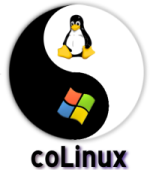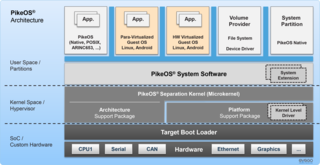Related Research Articles

An operating system (OS) is system software that manages computer hardware and software resources, and provides common services for computer programs.

An embedded operating system is an operating system for embedded computer systems. Embedded operating systems are a computer system designed to increase functionality and reliability for achieving a specific task. Depending on the method used for Computer multitasking, this type of operating system might be considered a real-time operating system (RTOS).

Cooperative Linux, abbreviated as coLinux, is software which allows Microsoft Windows and the Linux kernel to run simultaneously in parallel on the same machine.

MontaVista Software is a company that develops embedded Linux system software, development tools, and related software. Its products are made for other corporations developing embedded systems such as automotive electronics, communications equipment, mobile phones, and other electronic devices and infrastructure.

Unified Extensible Firmware Interface is a specification that defines the architecture of the platform firmware used for booting the computer hardware and its interface for interaction with the operating system. Examples of firmware that implement the specification are AMI Aptio, Phoenix SecureCore, TianoCore EDK II, InsydeH2O. UEFI replaces the BIOS which was present in the boot ROM of all personal computers that are IBM PC compatible, although it can provide backwards compatibility with the BIOS using CSM booting. Intel developed the original Extensible Firmware Interface (EFI) specification. Some of the EFI's practices and data formats mirror those of Microsoft Windows. In 2005, UEFI deprecated EFI 1.10.
The LynxOS RTOS is a Unix-like real-time operating system from Lynx Software Technologies. Sometimes known as the Lynx Operating System, LynxOS features full POSIX conformance and, more recently, Linux compatibility. LynxOS is mostly used in real-time embedded systems, in applications for avionics, aerospace, the military, industrial process control and telecommunications. As such, it is compatible with military-grade security protocol such as wolfSSL, a popular Transport Layer Security (TLS/SSL) library.
A hypervisor is a type of computer software, firmware or hardware that creates and runs virtual machines. A computer on which a hypervisor runs one or more virtual machines is called a host machine, and each virtual machine is called a guest machine. The hypervisor presents the guest operating systems with a virtual operating platform and manages the execution of the guest operating systems. Unlike an emulator, the guest executes most instructions on the native hardware. Multiple instances of a variety of operating systems may share the virtualized hardware resources: for example, Linux, Windows, and macOS instances can all run on a single physical x86 machine. This contrasts with operating-system–level virtualization, where all instances must share a single kernel, though the guest operating systems can differ in user space, such as different Linux distributions with the same kernel.
OS-level virtualization is an operating system (OS) virtualization paradigm in which the kernel allows the existence of multiple isolated user space instances, called containers, zones, virtual private servers (OpenVZ), partitions, virtual environments (VEs), virtual kernels, or jails. Such instances may look like real computers from the point of view of programs running in them. A computer program running on an ordinary operating system can see all resources of that computer. However, programs running inside of a container can only see the container's contents and devices assigned to the container.

In computer science, hierarchical protection domains, often called protection rings, are mechanisms to protect data and functionality from faults and malicious behavior.

PikeOS is a commercial hard real-time operating system (RTOS) featuring a separation kernel-based hypervisor. This hypervisor supports multiple logical partition types for various operating systems (OS) and applications, each referred to as a GuestOS. PikeOS is designed to facilitate the development of certifiable smart devices for the Internet of Things (IoT) by adhering to the high standards of quality, safety, and security across different industries. In instances where memory management units (MMU) are not present but memory protection units (MPU) are available on controller-based systems, PikeOS for MPU is an option for critical real-time applications, ensuring safety and security.
The following is a timeline of virtualization development. In computing, virtualization is the use of a computer to simulate another computer. Through virtualization, a host simulates a guest by exposing virtual hardware devices, which may be done through software or by allowing access to a physical device connected to the machine.
Lynx Software Technologies, Inc. is a San Jose, California software company founded in 1988. Lynx specializes in secure virtualization and open, reliable, certifiable real-time operating systems (RTOSes). Originally known as Lynx Real-Time Systems, the company changed its name to LynuxWorks in 2000 after acquiring, and merging with, ISDCorp, an embedded systems company with a strong Linux background. In May 2014, the company changed its name to Lynx Software Technologies.
A separation kernel is a type of security kernel used to simulate a distributed environment. The concept was introduced by John Rushby in a 1981 paper. Rushby proposed the separation kernel as a solution to the difficulties and problems that had arisen in the development and verification of large, complex security kernels that were intended to "provide multilevel secure operation on general-purpose multi-user systems." According to Rushby, "the task of a separation kernel is to create an environment which is indistinguishable from that provided by a physically distributed system: it must appear as if each regime is a separate, isolated machine and that information can only flow from one machine to another along known external communication lines. One of the properties we must prove of a separation kernel, therefore, is that there are no channels for information flow between regimes other than those explicitly provided."
Binary-code compatibility is a property of a computer system, meaning that it can run the same executable code, typically machine code for a general-purpose computer Central processing unit (CPU), that another computer system can run. Source-code compatibility, on the other hand, means that recompilation or interpretation is necessary before the program can be run on the compatible system.
SYSGO GmbH is a German information technologies company that supplies operating systems and services for embedded systems with high safety and security-related requirements, using Linux. For security-critical applications, the company offers the Hypervisor and RTOS PikeOS, an operating system for multicore processors and the foundation for intelligent devices in the Internet of Things (IoT).

XtratuM is a bare-metal hypervisor specially designed for embedded real-time systems available for the instruction sets LEON2/3/4, ARM v7 and V8 processors and RISC V processor.
An embedded hypervisor is a hypervisor that supports the requirements of embedded systems.

TenAsys is a privately owned company providing real-time software and services based on the x86 Intel Architecture and Microsoft Windows operating system.
In computing, a system virtual machine is a virtual machine (VM) that provides a complete system platform and supports the execution of a complete operating system (OS). These usually emulate an existing architecture, and are built with the purpose of either providing a platform to run programs where the real hardware is not available for use, or of having multiple instances of virtual machines leading to more efficient use of computing resources, both in terms of energy consumption and cost effectiveness, or both. A VM was originally defined by Popek and Goldberg as "an efficient, isolated duplicate of a real machine".
References
- 1 2 Inc, Lynx Software Technologies (2017-10-25). "Lynx Software Technologies announces LynxSecure 6.0". GlobeNewswire News Room (Press release). Retrieved 2021-07-13.
{{cite press release}}:|last=has generic name (help) - ↑ DornerWorks (2021-02-01). "FreeRTOS on LynxSecure Enables Complex Industrial Systems with a Path to Certification". DornerWorks. Retrieved 2021-06-20.
- ↑ Marketing, Ian Ferguson | VP. "What Are the Most Popular Real-Time Operating Systems?". www.lynx.com. Retrieved 2021-06-20.
- ↑ EE Times, Online magazine (2009). "LynxSecure 3.0 Separation Kernel Hypervisor for High Assurance".
- ↑ "LynuxWorks enhances LynxSecure kernel". automation.com. Retrieved 2021-06-20.
- ↑ Eddy, Nathan (2011-03-04). "LynuxWorks Announces LynxSecure 5.0 Virtualization Performance Booster". eWEEK. Retrieved 2021-07-13.